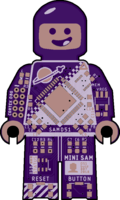MINI SAM D51-007
author: bwshockley
2 layer board of 0.96 x 1.60 inches (24.4 x 40.7 mm)
Uploaded:
July 31, 2018
Shared:
July 31, 2018
Total Price:
$7.65
Mini SAM D51-007
Mini SAM D51 is a LEGO® minifigure-sized development board based on the Microchip SAMD51G 48-Pin 32-Bit ARM® Cortex®-M4F MCU running at 120Mhz. If you are familiar with some other of my minifigure-sized boards, you’ll notice I managed to create this one in a 2-layer format, which saves us money.
On-board Features
I/O
The board includes a usb-micro interface for programming and power. It also has pad layouts for two single row 2.54mm pitch smt headers on the back. It is designed to be protoboard friendly and when populated the headers are the same width as a DIL package (7.62mm or .3") and span the center of a protoboard. In addition, there is a standard 10-pin Cortex programming port at 0.05" spacing to program the chip’s firmware/bootloader - please note I’ve modified this layout slightly to allow for easier POGO pin usage and this will probably not work as well for a soldered in place header as the holes are probably too small.
Mini SAM D51 includes two LED indicators; a standard Arduino “Built-In” LED and an APA102 RGB LED - useful for CircuitPython - and available for programming in Arduino as well. There are two built-in buttons as well; a RESET button and a user programmable BUTTON.
Memory
In order to support CircuitPython, a 2MB Quad-SPI flash memory chip is included. This provides plenty of space for the CircuitPython program as well as space for user programming.
Other
The board includes a 500mA 3.3V regulator, more than enough to power this little board and its built-in features. The micro-USB circuitry includes optional provisioning for case grounding and ESD protection. Finally, The AREF input and recommended Analog and Digital power separation is present on the board.
BOM
Github linked BOM includes everything required to fully populate the board. Please note the optional items in the schematic on Github
Arduino
Arduino FIRMWARE/BOOTLOADER is in-work. The goal is a bootloader that has all functions working and all on-board features usable with “Built-In” terminology in Arduino, i.e. LED_BUILTIN, MOSI, MISO, SCK, and BUTTON_BUILTIN.
CircuitPython
CircuitPython work is planned and will utilize the wonderful work done for the Adafruit ItsyBitsy M4 - as it is essentially the same board.
Open Source
Please check my Github for the latest design files and bootloade/firmware. More details can be found on Github
Mini SAM D51-007
Mini SAM D51 is a LEGO® minifigure-sized development board based on the Microchip SAMD51G 48-Pin 32-Bit ARM® Cortex®-M4F MCU running at 120Mhz. If you are familiar with some other of my minifigure-sized boards, you’ll notice I managed to create this one in a 2-layer format, which saves us money.
On-board Features
I/O
The board includes a usb-micro interface for programming and power. It also has pad layouts for two single row 2.54mm pitch smt headers on the back. It is designed to be protoboard friendly and when populated the headers are the same width as a DIL package (7.62mm or .3") and span the center of a protoboard. In addition, there is a standard 10-pin Cortex programming port at 0.05" spacing to program the chip’s firmware/bootloader - please note I’ve modified this layout slightly to allow for easier POGO pin usage and this will probably not work as well for a soldered in place header as the holes are probably too small.
Mini SAM D51 includes two LED indicators; a standard Arduino “Built-In” LED and an APA102 RGB LED - useful for CircuitPython - and available for programming in Arduino as well. There are two built-in buttons as well; a RESET button and a user programmable BUTTON.
Memory
In order to support CircuitPython, a 2MB Quad-SPI flash memory chip is included. This provides plenty of space for the CircuitPython program as well as space for user programming.
Other
The board includes a 500mA 3.3V regulator, more than enough to power this little board and its built-in features. The micro-USB circuitry includes optional provisioning for case grounding and ESD protection. Finally, The AREF input and recommended Analog and Digital power separation is present on the board.
BOM
Github linked BOM includes everything required to fully populate the board. Please note the optional items in the schematic on Github
Arduino
Arduino FIRMWARE/BOOTLOADER is in-work. The goal is a bootloader that has all functions working and all on-board features usable with “Built-In” terminology in Arduino, i.e. LED_BUILTIN, MOSI, MISO, SCK, and BUTTON_BUILTIN.
CircuitPython
CircuitPython work is planned and will utilize the wonderful work done for the Adafruit ItsyBitsy M4 - as it is essentially the same board.
Open Source
Please check my Github for the latest design files and bootloade/firmware. More details can be found on Github

